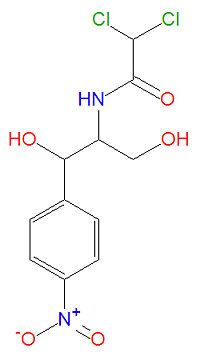Chloramphenicol
|
| |||||||
| chloramphenicol | |||||||
| |||||||
| Uses: | antibiotic | ||||||
| Properties: | |||||||
| Hazards: | toxicity | ||||||
| |||||||
Chloramphenicol was the first broad-spectrum antibiotic discovered, in 1947, from Streptomyces venequelae cultures. Although it is active against a wide variety of organisms including tetracycline-resistant vibrios, toxicity and safety concerns, such as bone marrow damage and anemia, typically limits its use to only the treatment of very serious infections, such as cholera and typhoid fever. The antibiotic works by binding to bacterial ribosome 50S subunits and inhibiting bacterial protein synthesis.
Chemistry
Chloroamphenicol, or 2,2-dichloro-N-[1,3-dihydroxy-1-(4-nitrophenyl)propan-2-yl]acetamide, has molecular formula C11H12Cl2N2O5 and molecular mass 323.1294 g/mol. The drug is referred to by several names, including CAF, CAM, CAP, chloramphenicole, chloramfenikol, chloroamphenicol, cloroamfenicolo, CPh, D-Chloramphenicol.
References
The most up-to-date information about Chloramphenicol and other drugs can be found at the following sites.
- Chloramphenicol - FDA approved drug information (drug label) from DailyMed (U.S. National Library of Medicine).
- Chloramphenicol - Drug information for consumers from MedlinePlus (U.S. National Library of Medicine).
- Chloramphenicol - Detailed information from DrugBank.
